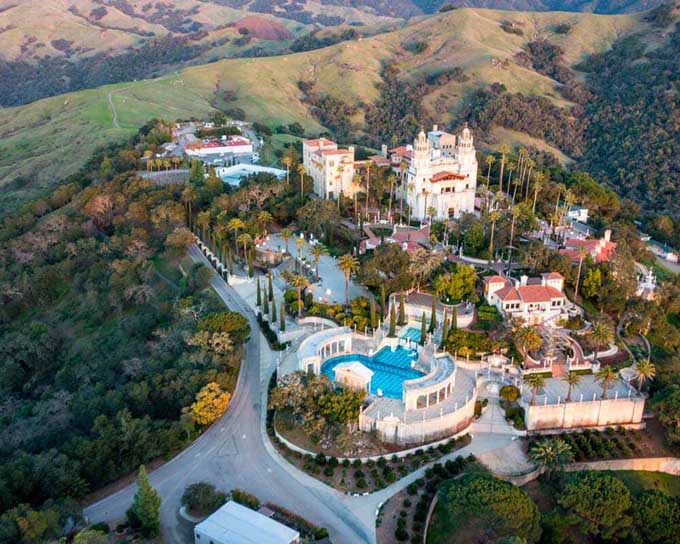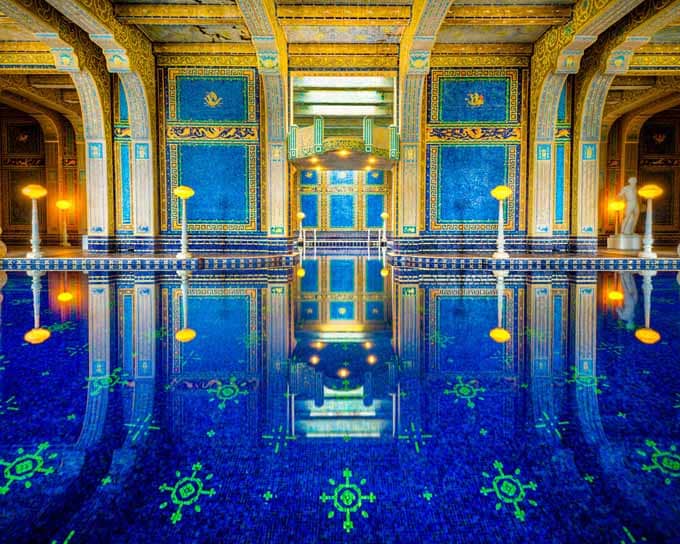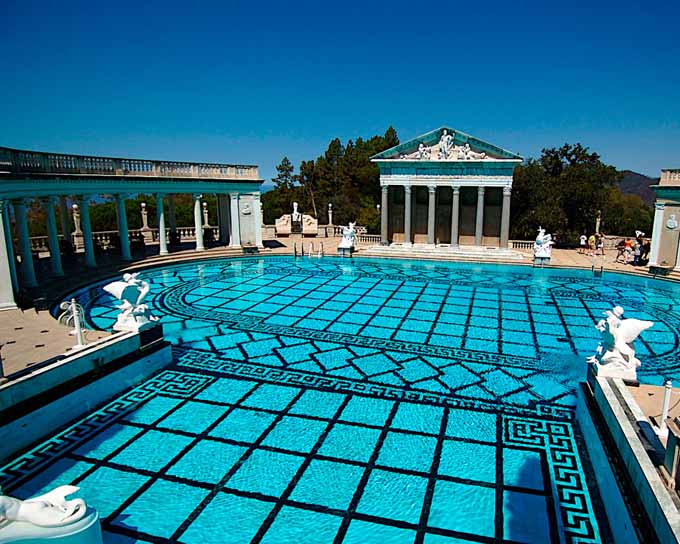Maybe you’ve seen the G.U.Y. music video from Lady Gaga. We can agree that it is not the best video the Italo-American singer has delivered, but within its footage we can find scenes from two of the most wonderful pools on the planet. The Neptune pool and the Roman pool at Hearst Castle in California.
The Hearst castle
The history of Hearst Castle begins in 1865, when George Hearst acquired 40,000 acres of land that would later be inherited by his son William Randolph Hearst, who continued to buy land around San Simeon, California, until reaching 250,000 acres.
William, with the help of his faithful architect Julia Morgan – the first woman admitted in the School of Fine Arts of Paris, and the first architect of California – conceived the retreat that named as “La cuesta encantada”.
Due to its delicate health, Hearst left the site back in 1947. The farm, which remained unfinished, had 165 rooms with 123 acres dedicated to gardens, terraces, swimming pools and areas for walking. All adorned with a legendary art collection.
But who was William Randolph Hearst?
Perhaps you also have seen the legendary Orson Welles film, Citizen Kane, whose story is about the life and legacy of Charles Foster Kane. A fictional character based on William Randolph Hearst himself.
Naturally, Hearst did everything in his power to attempt against the release of the film, but in the years of the Great Depression the power of Hearst was feeble and the only thing he achieved was to reduce the box office outcome.
But why was Mr. Hearst so powerful?
Among other things, for his business empire in the media. William owned 28 national newspapers; In addition to various publishing companies, radio stations, and magazines such as the Cosmopolitan.
William Randolph Hearst is one of the most famous forerunners of what we know today as the “yellow press”. A megalomaniac who used his power in the media to favor his commercial and political interests, manipulating information at will and creating all kinds of scandals. For example, it was one of the key pieces for conflicts like the War of Cuba.
But we better stick to the castle, more beautiful than the story of its founder.
The Hearst Castle swimming pools
The construction for the first of the two Hearst Castle swimming pools, the Neptune pool, began in 1924 and ended in 1936. Three pools were built on the site, each larger than the previous. But Hearst, using his numerous children as an excuse, wanted this pool even bigger.
The second version, finished in 1927, already had a larger size, and included a waterfall with concrete steps from which the water flowed. The sculptures of Neptune and the Nereids were located crowning this waterfall.
The central part of the pool and the north end were made with parts of the facade of an old Roman temple that William had bought and moved, stone by stone, from European lands to San Simeon.
The current version of this pool was completed in 1936, with almost 32 meters long by 17 wide with a maximum depth of 1.5 m. It’s not Gre’s Haiti swimming pool, but almost.
The Roman pool we can find inside the castle replicates the style of an old Roman bath, such as the Baths of Caracalla from 217 AD. In turn, the mosaics that decorate it are inspired by those of the mausoleum of Gala Placidia in Ravenna, Italy, from the 5th century.
Decorated by the ceramist and muralist Camille Solon, the mosaics of the Roman pool are made up of smalti glass tiles. Blue and golden crystals reminiscent of Venetian glass which confer a fluorescent luminosity to the room, and especially the water.
No wonder why Lady Gaga chose a location as dreamy as this to shoot his music video and boogie with his team of dancers on the water.
Leaving the pools aside, other prominent areas of the Castle include a wine cellar that was built during the prohibition era and hid secret chambers to protect some pieces of the art collection.
At the time, the castle also had the largest private zoo in the world, which kept species from all over the planet. Without forgetting the private airport so that the architect Julia Morgan and any person designated for the creation of the farm could come quickly to the door of Casa Grande.
Ignoring some inevitable remodeling, the mansion keeps its decoration intact and still keeps some of the pieces of art that were not sold or donated to museums, such as Egyptian statues, sarcophagi or Roman tapestries.
Currently, Hearst Castle is public access and one of the greatest attractions of the state of California. A must for those planning a trip along the west coast of the United States.



Comments
Sus datos serán tratados por MANUFACTURAS GRE S.A. y por FLUIDRA S.A., con la finalidad de gestionar sus comentarios y dudas en el blog y, en su caso, ponernos en contacto con Usted para solucionarlas. Puede consultar más información sobre el tratamiento de sus datos y cómo ejercer sus derechos, tal y como se describe en la Política de Privacidad.